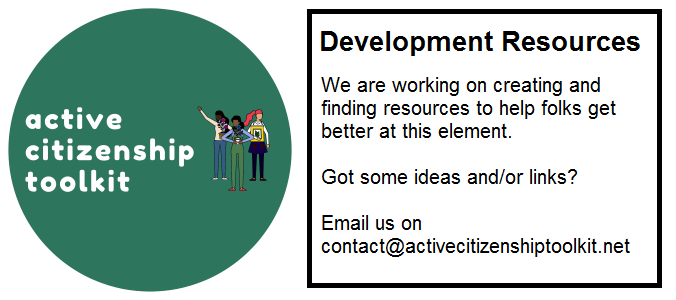Element Descriptor
Having a stall at a festival, meeting, rally etc is a tried and tested repertoire. Being able to hand out literature, answer basic questions and deal with disruptors and trolls in a compassionate and effective way is an under-rated skill.
Level descriptors
| Novice | Practitioner | Expert | Ninja |
|---|---|---|---|
| Occasionally helps out a stall when invited Spends most of their time behind the stall (the comfort zone) Will speak to the public if they approach the stall | Regularly helps out at stalls Knows how to set up a functional stall Actively engages people passing the front of the stall Understands what the aim of the stall is Refers tricky questions to more experienced volunteers Follows up on any actions / sign-up sheets | Identifies stall opportunities Plans an eye-catching stall with props & fun activities Acts as a stall leader, coordinating volunteers & equipment Ensures all volunteers are briefed on the purpose of the stall Actively engages individuals and groups of people wherever they are Knows how to deal with tricky questions Recruits volunteers to the cause | Proactively identifies stall locations based on campaign need Defines purpose of stall and objectives in advance Knows how to deal with arguers / time-wasters – has an exit strategy Networks with other stall holders Is prepared to speak to politicians/media if the opportunity arises Recruits paying members to the cause Reviews stall afterwards to identify what went well / what to do better & shares results |
Element Overview Essay
This is a draft. If something doesn’t make sense, or you see typos, or if you have further ideas, please email us on contact@activecitizenshiptoolkit.net
The reason this is done badly is that it’s often very boring work which only the rusted on members of a group do. And they do it as a chance to chat with their mates.
The consequences of this are the same old faces as seen on stalls and therefore disregarded the same old patterns, the same old interactions which have not got us to where we need to go.
So, if we’re serious about diversifying movements, we need to be serious about who sits on stalls.
We need to make it easier for people to start stalls in shorter rotors with better training to demystify what’s going on.
Basic advice around eye contact, smiling, asking questions rather than giving long rants? Answering questions, super briefly or slightly less briefly, having good material to dish out.
And if we’re doing stalls in a pandemic, making sure that we are doing it safely.
- Rehearse a few lines in advance
- Role-play a few scenarios
- Meet up before (briefly) / and after (longer) … to catch up properly rather than trying to do it when on the stall
- Maybe a make video?
Development Resources

Assessment Resources

